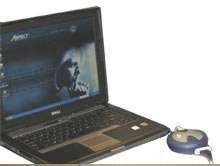Brainwave Monitoring Device
(PhysOrg.com) -- Researchers conducted a study at 9 sites in the U.S. with 375 people suffering from major depression. The testing takes about 15 minutes and could help people suffering from depression find fast relief.
In the study researchers used a customized version of quantitative electroencephalography (QEEG) to study brainwave patterns.
Brain waves are measured by a few electrodes attached to a strap that is placed around a patient's forehead. The electrodes plugs into a device that digitizes and filters the EEG signals from the brain. The device is then plugged into a computer for analysis.
The device, which is developed by Aspect Medical Systems, does not require any long term specialized training. In only a few hours a doctor or assistant can begin using the device for patient analysis.
Selecting the right antidepressant medication is commonly done by trail-and-error. Antidepressants must be taken for approximately 8 weeks before it's known whether the medication will have an effect or not. This process usually has to be repeated a few additional times before it can be determined which drug is most effective.
The study involved researchers measuring brainwave activity on patients before being administered any medication. After administering patients a popular antidepressant they were assigned one of three study groups. The second group switched to another antidepressant and the third group was taking both medications.
To predict which patients responded to the first drug, researchers looked for particular changes in brainwave patterns between the first and second QEEG. Researchers were able to accurately predict whether the patient would respond to the antidepressant 74 percent of the time which is much more accurate than current methods available.
The study can also be applied to drugs for other diseases, such as Alzheimer's and schizophrenia disease.
© 2009 PhysOrg.com


















